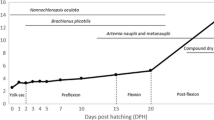Abstract
In life cycle of Angiostrongylus costaricensis, veronicellidae mollusks participate as the invertebrate host while rodents as the main vertebrate host. The current work shows a sequential larval development of A. costaricensis in Sarasinula marginata, individually killed and digested from day 1 to 43, post infection. Some larvae, recovered from sedimentation, were submitted to selective staining after paraffin embedded or inclusion in JB-4 to study inner structures. As control, four slugs were used, two killed at the beginning of infection and the others at the end of the experiment. At day 2 post infection, larvae were motionless and thick, presenting initial retention of granules. At day 4, L2 were detected, persisting until 43 days post infection. Larvae L2 displayed a large amount of granules rich in lipids and carbohydrates through its overall body, with more accumulation at the medial third corresponding to the esophagus–intestine transition site. Lipid granules, the main energetic source, were located at the basal and apical regions of intestinal cells. Both L1 and L3 presented bilateral alae, which is also common in other nematodes. Transition forms between L2 to L3 molts were also observed.



Similar content being viewed by others
References
Bennett HS, Wyrick AD, Lee SW, McNeil JH (1976) Science and art in preparing tissues embedded in plastic for light microscopy with special reference to glycol methacrylate glass knives and simple stains. Stain Technol 51:71–97
Cabaret J (1987) Age susceptibility of molluscan intermediate hosts to protostrongylid nematodes. Am Soc Parasitol 73:557–858
Carson FL, Martin JH, Lynn JA (1973) Formalin fixation for electron microscopy: a re-evaluation. Am J Clin Pathol 59:365–375
Cheng TC, Alicata JE (1965) On the mode of infection of Achatina fulica by the larvae of Angiostrongylus cantonensis. Malacologia 2:267–274
Gerichter CB (1948) Observation on the life cycle history of lung nematodes using snails as intermediate hosts. A J Vet Res 9:109–112
Graeff-Teixeira C, Camillo-Coura L, Lenzi HL (1991) Clinical and epidemiological studies on abdominal angiostrongyliasis in southern Brazil. Rev Inst Med Trop São Paulo 33:375–380
Guilhon J, Gaalon A (1969) Evolution larvaire d’un nématode parasite de l’appariel circulatoire du chien dans l’organisme de mollusques dulçaquicoles. C R Acad Sci 268:612–615
Halvorsen O, Skorping A (1982) The influence of temperature on growth and development of the nematode Elaphostrongylus rangiferi in the gastropods Arianta arbustorum and Euconulus fulvus. Oikos 38:285–290
Hori E, Yamaguchi K, Fujimoto K, Nishina M, Takahashi M (1985) Experimental studies on the development of Angiosttongylus cantonensis larvae in mollusks: development under low temperatures. Jap J Parasit 34:272–284
Ishii AI (1984) Effects of temperature on the larval development of Angiostrongylus cantonensis in the intermediate host, Biomphalaria glabrata. Z Parasitenkd 70:375–379
Jenkins EJ (2006) Bionomies of larvae of Paralaphostrongylus odocoilei (Nematoda: Protostrongylidae) in experimentally infected gastropod intermediate hosts. J Parasitol 92:298–305
Junqueira LCU, Bignolas G, Brentani R (1979) Picrosirius staining plus polarization microscopy, a specific method for collagen detection in tissue sections. Histochem J 11:447–455
Kutz SJ, Hoberg EP, Polley L (1999) Experimental infections of muskoxen (Ovibos moschatus) and domestic sheep with Umingmakstrongylus pallikuukensis (Nematoda: Protostrongylidae): parasite development, population structure and pathology. Can J Zool 77:1562–1572
Kutz SJ, Hoberg EP, Polley L (2001) Umingsmakstrongylus pallikuukensis (Nematoda: Prothostrongylidae) in fastrops: larval morphology, morphometrics and development rate. J Parasitol 87:527–535
Lv S, Zhou XN, Zhang Y, Liu HX, Zhu D, Yin WG, Steinmann P, Wang XH, Jia TW (2006) The effect of temperature on the development of Angiostrongylus cantonesis (Chen 1935) in Pomacea canaliculata (Lamarck 1822). Parasitol Res 99:583–587
Mendonça CLF, Carvalho OS, Mota EM, Pelajo-Machado M, Caputo LFG, Lenzi HL (1999) Penetration sites and migratory routes of Angiostrongylus costaricensis in the experimental intermediate host (Sarasinula marginata). Mem Inst Oswaldo Cruz 94:549–556
Mendonça CLF, Carvalho OS, Mota EM, Pelajo-Machado M, Caputo LFG, Lenzi HL (2003) Angiostrongylus costaricensis and experimental infection of Sarasinula marginata—II. Elimination routes. Mem Inst Oswaldo Cruz 98:893–898
Morera P (1973) Life history and redescription of Angiostrongylus costaricencis Morera and Céspedes, 1971. Am J Trop Med Hyg 22:613–621
Mota EM, Lenzi HL (1995) Angiostrongylus costaricensis life cycle: a new proposal. Mem Inst Oswaldo Cruz 90:707–709
Mota EM, Lenzi HL (2005) Angiostrongylus costaricensis: complete redescription of the migratory pathways based on experimental Sigmodon hispidus infection. Mem Inst Oswaldo Cruz 100:407–420
Pearse AGE (1968) Histochemistry. Theoretical and applied. J & A Churchill, London
Rachford FW (1976) Host–parasite relationship of Angiostrongylus cantonensis in Lymnaea palustris I. Intramolluscan larval growth and development. Exp Parasitol 39:377–381
Rey L (2001) Nematóides parasitos do homem. In: Rey L (ed) Parasitologia. Guanabara Koogan S.A., Rio de Janeiro, pp 549–561
Roberts LS, Janovy J Jr (2000) Gerald D. Schmidt & Larry S. Robert’s foundations of parasitology. McGraw-Hill, Dubuque
Rose JH (1957) Observations on the larval stages of Muellerius capillaris within the intermediate hosts Agriolimax agrestis and A. reticulatus. J Helminthol XXXI:1–16
Samson J, Holmen JC (1984) The effect of temperature on rates of development of larval Protostrohgylus spp. (Nematoda: Metastrongyloidea) from bighorn sheep, Ovis canadensis canadensis, in the snail Vallonia pulchella. Can J Zool 63:1445–1448
Schjetlein J, Skorping A (1995) The temperature threshold for development of Elaphostrongylus rangiferi in the intermediate host: an adaptation to winter survival? Parasitology 111:103–110
Skorping A (1984) Density-dependent effects in a parasitic nematode, Elaphostrongylus rangiferi, in the snail intermediate host. Oecologia 64:34–40
Solomon A, Paperna I, Markovics A (1996) The influence of aestivation in land snails on the larval development of Muellerius ef. capillaris (Metastrongyloidea: Protostrongylidae). Int Parasitol 26:363–367
Wallace GD, Rosen L (1969) Studies on eosinophilic meningitis. V. Molluscan hosts of Angiostrongylus cantonensis on Pacific Islands. Amer J Trop Med Hyg 18:206–217
Yousif F, Lammler G (1975) The effect of some biological and physical factors on infection of Biomphalaria glabrata with Angiostrongylus cantonensis. Parasitol Res 47:191–201
Author information
Authors and Affiliations
Corresponding author
Rights and permissions
About this article
Cite this article
Mendonça, C.L.G.F., Carvalho, O.S., Mota, E.M. et al. Development of Angiostrongylus costaricensis Morera and Céspedes 1971 (Nematoda: Angiostrongylidae) larvae in the intermediate host Sarasinula marginata (Semper 1885) (Mollusca: Soleolifera). Parasitol Res 102, 861–865 (2008). https://doi.org/10.1007/s00436-007-0834-y
Received:
Accepted:
Published:
Issue Date:
DOI: https://doi.org/10.1007/s00436-007-0834-y




